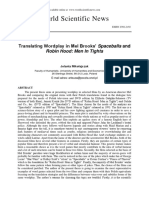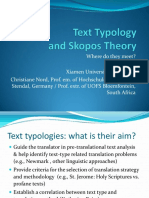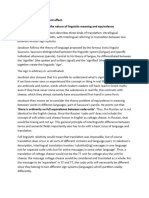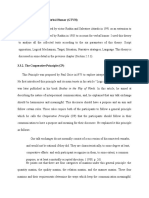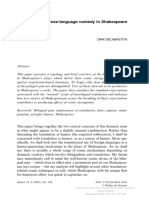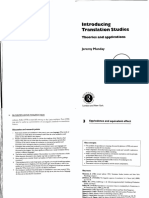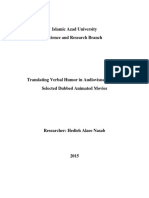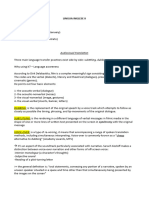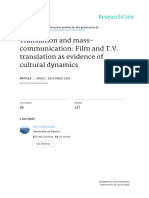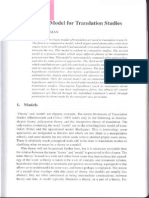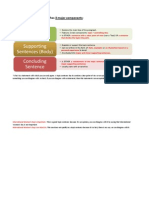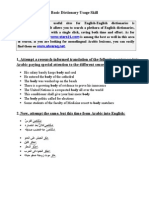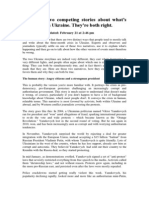100% (1) 100% found this document useful (1 vote) 489 views 20 pages Problems of Translating Humour in Subtitling
Copyright
© © All Rights Reserved
We take content rights seriously. If you suspect this is your content,
claim it here .
Available Formats
Download as PDF or read online on Scribd
Go to previous items Go to next items
Save Problems of Translating Humour in Subtitling For Later Problems of Translating Humour in Subtitling!
HosseinVossoughi" and Ladan Saba"
Abstract
This paper deals with the translation of humour in subtiting. The research
attempts to explore notions of subtiting and humour in theory and to
manipulate the strategies used in practice. The study used a descriptive
‘approach in answering the bwo questions: Is subtiting target language/cutture
‘oriented or not? And are there any certain types of strategies employed by
subtitlers in transiating humour in subtiting? In this article, a short theoretical
discussion about the main topics: audiovisual transtation especially subtting,
and humour will be given. The material for the study consists of two American
‘feature fins ‘Dumb and Dumber! (1994) and Liar Liar'(1997) both with Persian
‘subtitles. In the analysis 2 classification of humour is made and then based on
them, the strategies which were employed by the subtitiers in trensiating
‘humour are analyzed and discussed.
Key Words: huciovisua transition, subtting, humour, norm, strategies
Introduction
‘As Jaskanen (2001) states, humour is a vehicle for mass entertainment and itis
becoming Increasingly pert of the context ot intercultural communication,
Television nowadays offers feature films and TV series where humour is either
{2 primary element or a secondary one. Moreover, translators are often faced
with the task of having to translate seemingly untranslatable humour while not
reducing the effect, which invariably tests their capacty for making creative
solutions.
"This paper was recived on 25/5/2005 and approved on 21/09/2005,
" Professor, Teacher Training Unvesty; mal hvessouahi78@ahoo.com
* MA Graduate from Islamic Azad University, Science and Pasearch Campus; e-ma
ladan_saba@hotmal.com�In this paper, problems in subtiting are approached from the viewpoint
‘of and difficuties in translating humour. The article addresses the two
‘questions:
4, Can a SL oriented translation communicate the humour of the original
to the target audience without breaking norms? And,
2. Are there any special strategies employed by subtiters in transiating
humour in subtiting?
Jn order to take the safe side and get the crucial responses to the above
‘mentioned questions, the researchers have proposed the following hypotheses:
+ Translating humour in subtiting is target language/cutture oriented,
‘+ There are certain types of strategies employed by subttlers in translating
‘humour in subtiting.
1. Theoretical discussions
1.4 Subtitling
Henrik Gottieb (1998) says, since 1929, when the first sound films reached an
international audience, two methods of film translation have been dominant:
subtiting and dubbing.
He defines subtiting, ike any other type of translation by two factors:
semiotic composition and time duration.
‘Subtiting is defined in Shuttleworth and Cowie (1997, p. 161) as "The
process of providing synchronized captions for fim and television dialogue.”
Gottieb describes subtitles or captions as transcriptions of flm or TV dialogue
Presented simultaneously on the screen. He further adds (1998, p. 245)
“Subtitles consist of one or two lines of an average maximum length of 35
characters. As a rule, subtitles are placed at the bottom of the picture and are
ether centred or left-aligned.�‘Thus, Gottlab (1992) defines subtitling a9 (2) written, (2) auuttive (Le,
New verbal material is added in the form of subtities), (3) immediate, (4)
synchronous and (5) polymedial (Le. atleast two channels are employed) form
of translation,
In this study, subtitling is defined as transcription of film or TV dialogue
presented simultaneously on the screen; It's additive, immediate, synchronous,
‘and written and polymedial form of translation,
Now let us consider subtiting types. We have four diferent types of
subtiting, Gottileb (1998) follows Jakobson in distinguishing between different
forms of subtiting. From a linguistic viewpoint, he maintains there are
Intraingual subttting and interlingual subtting, Intralingual subtitling is in
the original language, it includes: subtitling of domestic programs for the deaf
‘and hard of hearing and subtiting of foreign language programs for language
learners. Moreover, he adds intralingual subtiting Is vertical, in the sense that it
Involves taking speech down in writing, changing mode but not language.
Interlingual subtitling is between two languages. This type is diagonal, in
the sense that the subtiter crosses over from speech In one language to writing
In another, thus changing mode and language.
Technically speaking, Gottlieb (ob. cit.) says, subtites can be (|) open
‘subtitle that Is not optional. These Include: cinema subtitles, which either are
2 physical part of the film or transmitted separately, and interlingual television
subtites, transmitted on terrestrial and broadcast as part of the television
Picture. And (i) leased Subtitling is optional and transmitted as teletext. This
type includes television subttles for the deaf and hard of hearing, selected by
the individual viewer on @ remote-control unit and generated by a decoder in
the television set; and intertingual television subtitles transmitted by satelite,
allowing different speech communities to receive diferent versions of the same
program simultaneously.�Several scholars have talked about diferent subtiting constraints. What
distinguishes AVT (audiovisual translation) from other forms of translation is
that It involves both technical and contextual constraints, Gottlieb (1992)
discusses textual (qualitative) and formal (quantitative) constraints on television
subtitling. Textual constraints are those imposed on the subtitles by the
Visual context of the film, such as the need to reduce the original message,
whereas formal constraints are the space factor (a maximum of two lines are
‘allowed, with some 35 characters each) and the time factor, Particularly the
time fector plays a pivotal role in the decisions that translators. make.
‘Traditionally 5-6 seconds have been considered sufficient for reading a two-
liner.
Different scholars have identified different strategies in translating
subtiting. The classifications proposed by Gottlieb (1992) and Jaskanen (2001)
‘made the basis ofthe taxonomy i this study.
Gottlieb has devised a set of strategies used by translators (1992). They
are as follows:
(2) Expansion,
(2) Paraphrase,
(2) Transfer,
(4) Imitation,
(5) Transcription,
(6) Disocation,
(7) Condensation: retaining both meaning and most ofthe stylistic Features
of orginal,
(8) Decimation: using abridged expressions and a reduction in content,
(8) Deletion: deals with non-verbal content, and
(10) Resignation.
‘Among these strategies, condensation is usually seen as the essence of
subtitling. According to Gottlieb (1992), with strategies 1-7, we get a more or
less adequate rendering of the source text material into the target language,
‘whereas strategies 8-10 involve some degree of semantic and stylistic loss.�Jaskanen (2001) divides the strategies employed by translators in terms
of 2 SL-TL continuum into three categories: exoticization, naturalization and
neutralization.
‘She says (0b. ct.) Exoticization Is here what Toury (1995, p. 56) called
‘adherence to source norms,’ retaining culturally specific elements in the ST of
slightly modifying them whereas naturalization means adapting the ST to
target culture norms. The choice between these two categories constitutes an
Initial norm (Toury, 1995). Between these two extremes there Is the middle
‘ground covered by neutralization |.e. choosing a culturally neutral solution,
However, she adds drawing exact boundaries between the three categories Is
difficult. The researchers used this categorization as 2 general category for the
translation strategies.
1.2 What is humour?
Walter Nash defined humour as follows:
It is an occurrence in a social play. It characterizes the interaction of
Persons In situations in cultures, and our responses to it must be
understood in that broad context, whether it makes the sudden
demand of wit, or whether it has the more discursive appeal of
description and anecdote (1985, p. 12).
In this study, the researchers have chosen to use ‘humour as a generic
term to cover any phenomena with humour-inducing potential.
‘There are several classification presented by different scholars but the
{wo that are more helpful areas follow:
Ross divides humour into:
1. Wordplay and ambiguity, This can occur at various levels of
language;
2) Phonology,
b) Graphotogy,
©) Morphology,
4) Lexis, and�©) Syntax.
2. Taboo-breaking,
3. Attacking a target,
4. Allusion and intertextualty, and
5. Nonsense or the absurd (1998: 4-8).
‘Schmitz (2002) classifies the dlvsion of humorous dlscourse into three
basic groups. The first group includes humour that obtains mainly from the
‘context and the general functioning of the world. To be more precise this type
Cf joke might be labeled the universal (or reality-based joke). In theory, jokes
‘belonging to this group would continue to be humorous in translation from
English into other languages. The second group Is the cultural joke or cuture=
based joke. Cultural jokes serve as mirrors of the socio-cultural practices of the
‘society and can inform the learner how some members of the community view
themselves. The third group is the linguistic joke or word-based joke based on
specific features in the phonology, morphology, or syntax of particular
languages. The cultural or linguistic jokes may not always be humorous in
transition,
Ross (1998) believes that television as a medium may carry audio and
Visual cues that guide or even dictate the subtitie’s choice. The visual
‘dimension of television as a medium means that translating humour in
television has a great deal in common with translating comic strips.
In screen translation, we have visual, audio, and contextual feedback.
‘Some puns are illustrative of negative visual feedback effect, where the image
‘makes it practically impossible to rewrite the humour in the TL. Here the image
carries ‘cues which support the dialogue’ (Roffe, 1995, p. 219), which cannot be
‘altered or removed. However, visual feedback is not necessarily always
‘negative; it can sometimes aid the dialogue, thus diminishing the scope of
‘cross-cultural translation problems (Nedergaard-Larsen, 1993).
Besides the visual feedback, there can be audio and contextual feedback,
"Negative audio feedback means that the audio cues on the soundtrack are so�strong that translators feel that they must lave, say, a culturally specific name
intact in the subtitle,
2. Methodology
2.1 Data Collection
In the study, the dota was collected from two sourees; feature fims and the
fim scripts.
“The data was gathered from analyzing the Persian subtitles of two 110
and 90 minutes Amercan feature fms. These are two comedy fis ‘Dumb and
Dumber’ and ‘Uar Lat screened In 1994 and 1997 featuring Jim Carrey. The
researchers chose these two comedy films after full viewing of 12 others. These
two are chosen because of the more humorous instances they possess.
1In order to ensure that no instance of humour I left out, the researchers
‘managed to access the script ofthe chosen fis. Purchasing the educational
© of Dariche, providing 110 film scripts, the researchers accessed the ‘iar
Liar’ script: Since ‘Dumb and Dumber’ script was not avaliable on the CD, the
researchers tried to get access to it through Internet. The script of ‘Dumb and
umber is available online under the www. script-o-rama.com,
2.2 Procedure
‘The procedure for obtaining required information consists of two parts; review
ofthe fim and reading ofthe fim scripts.
The researchers used the three-stage review carried out by subtitles’
edtors of S4C (Channel Four Wales) for reviewing the fms. The three stage
review comprises a spel-check, a preliminary reading of the subtited texts
followed by a fll viewing ofthe subtitle fim,
Stage
A speltcheck was carried out in order to detect spelling eros. Since identlying
speling erors has no effect onthe study, the resut obtained from ths stage
Was omitted through the analysis,�Stage It
‘At the second stage i.e. preliminary reading of the subtitled text, the
Concentration was solely on the linguistic contents of subtitle without being
influenced by the soundtrack, Since obtaining the subtitled text was impossible
It was done by placing the subtitied film with the speaker on the off mode —
thence no influence by the sound track. Through this process, Instances of lack
of clarity, ambiguity of meaning, inconsistency of terms, missing links between
subtitles, Incorrect translations and so on were identified, At this stage,
humorous instances based on the subtiies were extracted,
Stage 111
In this stage, the researchers had the full viewing of the subtitled film, This
Provided them with the opportunity to concentrate on the overall impression
‘created by the subttes in relation to the film, thereby instances which were let
‘out oF not understood as humorous were identified. After these two stages, a
list of humorous instances with thelr subtities was prepared.
‘After reading the scripts, the researchers identified differences
‘between the provided scripts and the shooting scripts and wrote down the
differences, After the identification and correction of the differences, another
list was provided. Then a comparison between the two lists was done and a
‘complete list of humorous instances of the two flms was arranged
3. Data Analysis
For analyzing the collected data, the researchers decided to ciassify them based
(on the types of humour. First, Jaskanen's (2001) humour classification was
‘adopted. In this classification, humour Is divided nto two groups of
intralinguistc and extralinguistic Humour. She defines Intralinguistic humour
as language related elements such as catchphrases and slangs; indirect
allusions such as advertisements, ete; and wordplays, puns and phrases. On the
‘other hand, she defines extralinguistic humour as culture-rlated elements
4
wt ed poe Copidiyehs a ey (her�like direct cultural references to TV programs, fllms, music, and other cultural
staples.
However, after more comprehensive analysis and investigation of the
data collected it became known that the above classification could not cover all
‘the humorous instances. So another classification similar to Schmitz’
Cassifcation (2002) is formulated. Moreover, it Is understood that humour
‘mode of expression can be linguistic and extralinguistic,
‘Based on the formulated classification humour is divided into:
1. Language based humour,
2. Cultural humour, and
3. Universal humour,
Language based humours are those that are based on specific
features In the phonology, morphology, syntax, lexis or language function of
Particular languages. These are catchphrases, and slangs; indirect allusions to
‘advertisements, and famous people, etc; wordplay and phrases.
Cultural humours are language specific and serve as mirrors of the
socio-cultural practices of the society. They are always a challenge for
‘translators and may not be humorous in transtation; and,
Universal humours are obtained mainly from the context and the
{general function of the world. Universal humours are understood by every
culture and in every society and there is normally no special problem in
translating them,
So the data was classified based on this Cassification, then the strategies
‘employed by the subtitiers were identified and a dassification of strategies was
Provided based on them,
3.1 An analysis of some humour-inducing elements in ‘Dumb
and Dumber’ and ‘Liar Liar’ and the strategies used�4s it has already been mentioned, the analysis is done based on humour
‘categorization discussed above. For analyzing the translation strategies, the
researchers used one stbtitle, Le. the amount of text seen on the screen at one
‘time, as the logical unt of transiation, The object of researchers! analysis was
‘often part of one subtle or it may occasionally extend over two or more
subtitles. However, the researchers think that at a conceptual level it is
reasonable to regard 2 subtitle as a unit of translation. Here are the
classification and some examples.
Language based humour
Language based humour instances found in ‘Dumb and Dumber’ and ‘Lar Liar’
are examples of wordplay, allusion and swearword.
Wordplay
Wordplay, or punning, was defined by Delabastita (1996, p. 128) broadly as
‘textual phenomena’ contrasting "linguistic structures with different meanings on
the basis of their formel simlarty. For the purposes of a more fine-grained
typology, puns can be further divided into such categories as homonymy,
homophony, homography, and paronymy according to the type and degree of
similarity (ob. cit).
Examples (1) and (2) below represent one of the most classical forms of
punning, i.e. homophony. In these two the subtitle used condensation strategy
le. retaining the meanicg and most of the stylistic features of the original; in
Jaskanen’s (2001) word ‘naturalization strategy’ that adapts the ST to target
culture norms.
1) [Maxc] My dag? Hes. a lar
Lies, Bey] A fia? I dont think you mean a Rar.
[Max:] Wel. he wear’sasuttand goes to court and talks tothe judge and,
(rs. Bery:] Oh, Ise .. ou mean he's a lawyer.
soph 599 Se ghee Ge oy [etal
Ss8b509 & [re FL]
Ae ee bg aS et 958 [rusts]
PALS Sane SLE 1 L831�Seo) SU! Soy pts OLT [ree ALT
wuss
In this example, the wordslay is between two homophone words ‘liar
and lawyer’ In the subtitle, their exact meaning that is 2) > and Jes. Is
Used, Since there is no other choices in Persian to keep the wordplay the
subtitir faced the correct solution; using Dalabastita's strategy of translating
‘pun’ into ‘non pun’ in which a pun is rendered simply by a phrase, retaining
‘one or both meanings of wordplay.
Example (2): A cop calling Harry to stop:
2) [state troopers] Pul over
(Harry ] No, i a cardigan! But thanks for noticing.
o13 465 Frag)
ess Ot ls SLRS ast) 6) oul Giga)
spose
What makes the remark humorous Is the facts that Harry misunderstood
the word ‘pull over" with ‘pullover’.
In this example, subtiier used the same strategy as Example (1) and
‘once again, the wordplay with sound is lost in the Th
In Example (3) Lloyd is teling Marry that being a limo driver is not his
real job and he and his fiend are saving money to open their own pet store; he
{goes on as:
DY — [Woyd:] 1 got worns,
‘[Mary:] I beg your pardon?
{[Woyd:] Thats whet wete gonna call t: 1 Got Worms. Were gonna
_spedalz in seling worm farms = you know, lke ant farms.
eats pas oe Feaeet)
rian
OH) pets alae pal gat Gute Sue Crag
HS al es pS dissk Le aad ppl o ps�inthis example, the subtler sed Wert transition for rendering the
ee arte Taare cones scum nN
eran. in Example (2), te wanslator Use tronster Stvatesy:
example (4) san instance of to of tongue:
9 rut deserve mae 0S
[Mary] Maybe Istoue be BIg 1%
eemaee 92 an ee Gael
+098
pape on ode ate (2827)
rts an instance of sip of recague becuse y's enon 19S) ©
sehoatsay wno desperately wats. to mae Tove! inthis example, the subtler,
ubsttte the utterance with 2 nesta cultural solution because of Some moral
rd ethical problem in TL cutare. Terelor ip Example (4) due to cultural
impicatins the transiator used SUbstntion strategy
vera nthe analysis Ws understood Hot in translating wordplays the
atrotegles employed are target leunguage oriented.
swearwords
one of the most diffcut areas tn -aiting fim the use of bad ena
‘swearwords. Once the subtler Ras vetased te type of exeression and
degree of obscenity: sepa teem
wre comected to taboo areas ts wil ‘ff substantial fromm cute ©
cquture (Schwartz, 2002, P. 39:
xomple (1)
4) [Brive] Whar 2 your probe” schmuck?�In Example (2), the swearwords are deleted and a neutral solution is
used, In Example (1), the strategy of substitution is used Le, the swearword is
substituted with another swearword in target cuture but with a less negative
meaning.
To sum up the strategies used for translating swearwords are
substitution and condensation.
‘After analyzing all the instances the analysis showed that in translating
languege-based humours, the subtitler used strategies that are mostly target
language oriented like condensation, trensfe, substitution, and expictation,
Here are some examples:
Cultural humour
Much of the humour in these two fms is cultura, so it requires an auclence
that recognizes it in the fist place. Communicating the connotatve load
associated with some of those cultural tems is by no means an easy task.
In cultural humour, semetimes the audlence is aware of the cuturl
reference as in Exemples (1) and (2). Its an Indirect reference to Jim Carrey
himselt:
2) [ax] 1. keeo making ts face mil get stuck that Way?
‘[Petcher:] As a mater of fact, some people make a very good
Ing that way.
fase tepals 98 1a tat oat aft Breed
Sake aphge
er dee Na GO) pone gk SLE 30 Tipp]
Its humorous since itis a reference to Jim Carrey’ profession and the
visual feedback presented will hep the viewer to understand the reference. The
subtler used communicative translation in rendering the humour and
transferred itt the TL audience.
Example (2) Is a cultural reference to a cosmetic product brand name.�2) (Petcher: Absolutely, Mestactor.
pps Le (rags)
‘This is undoubtedly one of the cultural staples that can be understood
easly and the subtler used teal trensation.
Lets look at examples that are highly culturally and socially bound.
Fst an instance of socal and cutural humour:
DY [Petcer:] Sse someone for everthing they've done. Or
send a fax fr ane of our grtend.
Bh Se te iL [gd
sarlayty aytaligs
‘The first sentence that 's @ social humour is over sighted due to
unknown reason for the researchers that may be intentional or unintentional
‘The subtier omitted the sentence and inthis way the viewer became deprived
Of understanding the socal humour; i. in that county you can sue everyone
for doing everything. In the second sentence, the word girfiend’ Is changed to
2 culturally neutral solution in the TL due to target cultore norms.
In some cases as in Examples (4) and (5), the humorous instance has a
contextual reference in other parts of film that are censored because of ethical
and moral problems in target culture. In translating these instances the subtler
usualy wll face with problem but here, the subtitler used literal translation and
left the burden on the viewer to understand the utterance and humour.
9) [Fletcher] Tve had better? (Petcher incapable of lying)
sets ee 4g bie [yeti]
‘The subtitler used itera translation so a humorous sentence is changed
to a non-humorous one. Ifthe subtiier used other strategies like explication,
the humour may be conveyed.
5) [irgnia:] Mr. Ret, you remember Kennet Falk, the man
‘rom the tape?
[fletcher] How can J forget?�Bee 1g SILA as A gy VT Es Late]
Foe Ost 3 Se Laat
Ses Bett Elpkee sob Coppi]
In this example, there is also a contextual feedback that Is censored
from the film, but tis time the subtier used another strategy and substitutes
the sentence with another choice that did not confuse the viewer of the
subtler lke the previous example. OF course, still a humorous utterance is
changed to a non-humorous,
To sum up majority of the culture specific humours are from the film
“Uar Uar and the subtler has most of the time substituted the SL cultural
problematic elements with a neutral target culture solution. Most of the
Instances are translated literally. The strategies used are mostly substitution
and neutralization ike in Examples (3) and (5). In Examples (1) and (2), the
subtler used transfer and naturalization strategies; in Example (4), the
subtler used teal transation and condensation strategy, The mast important
result after analyzing them is that after using substitution strategy most of the
humour in SL became non-humour in TL. Moreover, after analyzing this type of
humour the researchers become sure that the study hypothesis is confmed by
the fncings.
Universal humour
‘This type includes humours that are obtained manly from the context and the
general function of the word. Universal humours are understood by every
cuiture and in every society and these 1s netpelly no special problem in
Manslaths thet,
amples (1). (2) and (4) ar aos the samen al socebes
inesampe (1) 2‘publ eked Fetch for @ moment time but cher
ed to'heFend passed by, °° 7 Stee :
LD [Publicist] eens a coutle “of ‘reporters want to
‘tere ou about your big wn toca.
Retcher] How’ my hak jer?�Helis Gas 5) Gs Gots pad
PALS Aer lee FLy P5 ay al
Saal soke glans aoe [gpl]
Its a socal attitude that Is also the same in most of the cultures and
societies. As Schmitz (2002) says this kind of humour can be transiated without
major problems and since there is, aso a visual feedback the audlence can
easly understand the humour.
‘The subtitier used @ communicative translation and transferred the
‘meaning exectiy.
Example (2): A cop stops Fletcher and asks him If he knows why he has
stopped him, Fetcher incapable of lying says:
2) [Retcher:] Here goes, 1 sped, 1 followed too closely, Iran
_2 stop sign, [almost hit a Chevy, I sped some more. fad to yield
‘at a crosswalk. I changed lanes at an intersection; I changed lanes
‘without signaling while running a red ight and speeding,
{Cop:] is that al?
([Rietcher:] No. Ihave unpaid parking tickets.
BLE AEE gy EAL LID nes Oe [syphll
Uy sep 6235s opt a cae ALLS ays UL
2 RUS cep Uo 02s ALS ype og
AS! Ost ly LL le ks ky pk ge
eet yee Sand ile 31 Ape ge pay ote
snes cbse Ly pls
S354 ae oI Coy]
BA mI SLY ule se gt]
ples
Example (2) is @ universal concept and understandable in every society.
‘The subtitler used communicative translation and rendered the exact meaning
inthe TL.
‘Example (3) is a social attitude that Is the same among every cultures
‘and societies. A way of thinking that Is mostly conveyed by the younger
fe�‘generation to the older generation when the older ones are talking about the
risks of doing adventurous tasks.
3) [Loyd] Its realy nothing to worry about, Mary.
Statistically, they say you'e more ikely to get killed on the way to
the airport. You know, like in 3 headton crash, or fying of a cit
get rapped under @ gas tuck; that's the worst.
wake gut S|
Seb ose BLE ONS [ray]
DH gb GAS Ly al aly #Lfoggd 19 od LP od
O25 aS 5 sake 51 hepa agaps Solas ge Lut
EL Ga! SLE Osnls 61
‘The subtiter used communicative transaton adapting @ ST to target culture
norms and trensferred the meaning,
‘To sum up, the majority of universal humour instances in these two are
composed of social attitudes, behaviors, thinking and universal belies. The
subtitler usec communicative translation except in Examples (1), (2) and (3)
‘and transfer strategy. On the whole In transating instances of universal
humour, the translator faced with no special problem and used 2 target-
oriented approach.
4. Discussing the findings
‘Translation strategies in Persian subtitled versions of ‘Dumb &
Dumber’ and ‘Liar Lia
Based on the findings of the analysis and with the help of Jaskanen
‘lassification, the following table of strategies was formulated:
Es coe 7.
Exoticization ‘Neutralization: Naturalization
COnrission ‘Substitution Transfer
Resignation “Tanscription
‘Condensation
Enplictation.
Percentage and frequency of the strategies are presented in the following
tables:�Source z ca PB
‘Omission 2 2.05, 5
Resignation 2 0.05, 5
Substitution if 0.3055 3.55
“Transfer 4 (0.3868. 38.88
“Transcription 1 0.02, 2
‘Condensation 5 0.1368. Ba
plication 1 0.02, 2
Table 1: Frequency and Percentage ofthe Different Strategies Used
Source f RE Pe
SL 4 Oat Thin
sm i 033055 30.55
TL 2 0.5833 58.33
Table 2: Frequency and Percentage of the Strategies, Based on SL-TL Continuum
AAS it induced from the analysis the strategies used in ‘Dumb and
Dumber and Lar Liar’ are similar to some extent ‘Dumb and Dumber and Lar
Uae? subters’ approaches are mostly TL-oriented (naturalization) and
‘ccasionally even on the SL-TL continuum (neutralization); of course in some
Instances ‘Uar Lia’ subtiter also used SL: oriented (exoticizton) strategy.
On the whole, the findings suggest that the subtiiers have used TL.
‘oriented strategies, Its a surprising move, since the fms have both audio and
visual cues pointing towards the source culture. Indeed, the strategy may have
been chosen precisely because it passes for the TL culture, even if invites the
Viewers, as it were, to suspend their disbellet.
It s also induced that censorship ie. intentional omisson of scene leads
to establishment of TL norms and the strategies used in this instances are
‘mosty TL oriented.
4.1 Other Findings
‘According to the findings ofthe research, it can be inferred that subtitles used
both communicative and literal types of translation. Literal translation is mostly
used for translating wordplay and humorous instances that are highly socally
{and culturally bound, Tt is because the subtiters have thought that a literal
translation strategy functions adequately for the audlence or that they may
(x�have missed them in the first place, But on the whole, whenever the subtiier
‘sed the literal translation the humorous instance becomes non-humorous in
the TL. The communicative translation is mostly used for universal humours or
humours where the subtiter renders the exact meaning of ST to the TT.
It can also be induced that breaking textual norms can also result from a
conscious choice made by the subtitlers. The subtitiers then ignore negative
contextual feedback and adjust the original to the target culture because they
feel that a SL oriented rendering can not communicate the humour of the
original. Tt is extremely difficult to assess that whether certain pattems of
behavior on the part of the translator are due to personal taste and/or skil or
target culture norms or some thing in between. What is obvious Is that the
subtitlers observed the moral and ethical norms through their work.
5. Conclusions
‘The theoretical discussions and the findings of the study approved the
hypotheses underlying te study that translating humour in subtting is target
language/cuture oriented and that there are certain types of strategies
employed by subtitles in translating humour in subtiting.
‘Moreover, the reszarch found answers to the questions as follows:
1. Can a St oriented transiation communicate the humour of the original to
the target audience without breaking norms?
Based on the firdings obtained from the study, answer to the first
Question is negative, Instances were observed where the subtitler used the
source culture oriented translation by using a iteral o minimum change
strategy; this solution did not communicate the humour of the original to the
target audience.
2, Are there any special strategies employed by subtiiers in translating
humour in subtiting?
‘This question is fully answered and discussed. The strategies used are
‘mostly TL culture orlerted, though in some Instances SL culture orlented
”�strategies have been observed. On the whole, the intention of the subtters is
‘mostly towards TL culture oriented strategies with observing TL culture norms.
6. Final Words
Due to the increase in mass communication in more recent times, translation
for the screen has become more prevalent and more important. It should be
‘Noted that many inhabitants of smaller countries, such as Holland, Switzerland
‘or Denmark, may read more subtited films than translated books or magazines.
‘The interest in translation forthe screen has also been reflected by the fact that
some universities (Université de Lile, France and University of Copenhagen,
Denmark) have Introduced specialized courses (Gottlieb 1998)..
In ran, too, there is a recent move towards screening subtitled fllms in
cinemas, showing documentary programs in television and producing subtitled
films in CD formats. Therefore, this movement intensifies the need to accept
‘and emphasize audiovisual translation as a course of study In our universities.
‘At the end, its clear that the present study i, In fact, a starting point in
researches on translation studies in Iran and a means to pave the way for
further studies in AVT in Iran,
Works Cited
Delabastta, D. (1996), Introduction. The Translator, 2 (2), 127-139,
Gottieb, F. (1992). 'Subtiting ~ A New University Discipline’. In: Dollerup, Cay, etal
(ecs.), Teaching Translation and Interpreting (op. 161-170). Amsterdam: Joho
Benjamin.
Gottieb, H. (1998). Subtiting, In: M. Baker (ed,), Routledge Encyclopedia of
Transtation Studies (pp. 261-274). London New York: Routledge.
Jaskanen, 5. (2001) ‘Fine Kettle of Fish’ [Onn]. Avaliable: htt. /émen. helsinki.
Retieved 31/10/2002.
Nash, W. (1985). The Language of Humour. Style and Technique in Comic Discourse,
USK: Longman.
Nedergaaré-Larsen, B. (1993). 'Culturebound Problems in Subtting’. Perspectives:
‘Studies in Translatology, 2, 207-241
Roffe, 1. (1995). "Teaching, Learning and Assessment Strategies for Intelingual
Suttiting’. Journal of Muttiingual and Mulcutura! Devetoornent, 16 (3), 215~
25.
20.





